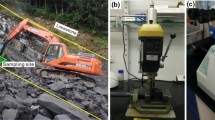Abstract
An understanding of crack propagation is critical for the development of rock mechanic models. To study the propagation of internal cracks in situ and determine their formation mechanism, a series of uniaxial compression tests on shale specimens were conducted using a novel setup that combines X-ray micro-computed tomography (X-ray micro-CT) with a uniaxial loading apparatus, which allows CT scans to be performed during compression. Macro- and micro-scale internal cracks were extracted from CT images collected after various stages of deformation through image thresholding segmentation, providing a record of the evolution of damage within the specimens, characterized by crack closure, generation, growth, and penetration. In addition, macroscopic cracks with two distinct orientations were observed and their formation mechanism was further determined. Furthermore, test results show that the distribution of pyrite grains influences the formation of cracks at the meso- and macro-scales. These results are significant for understanding crack propagation and the failure of shale.












Similar content being viewed by others
References
Ashby MF, Hallam SD (1986) The failure of brittle solids containing small cracks under compressive stress states. Acta Metall 34(3):497–510
Belytschko T, Black T (1999) Elastic crack growth in finite elements with minimal remeshing. Int J Numer Meth Eng 45(5):601–620
Bobet A, Einstein HH (1998) Fracture coalescence in rock-type materials under uniaxial and biaxial compression. Int J Rock Mech Min 35(7):863–888
Carter BJ, Lajtai EZ, Yuan YG (1992) Tensile fracture from circular cavities loaded in compression. Int J Fracture 57(3):221–236
Chang SH, Lee CI (2004) Estimation of cracking and damage mechanisms in rock under triaxial compression by moment tensor analysis of acoustic emission. Int J Rock Mech Min 41(7):1069–1086
Duan YT, Li X, He JM, Li SD, Zhou RQ (2018) Quantitative analysis of meso–damage evolution for shale under in situ uniaxial compression conditions. Environ Earth Sci 77(4):154
Eftekhari M, Baghbanan A, Hashemolhosseini H (2016) Crack propagation in rock specimen under compressive loading using extended finite element method. Arab J Geosci 9(2):1–10
Feng XT, Chen S, Zhou H (2004) Real-time computerized tomography (CT) experiments on sandstone damage evolution during triaxial compression with chemical corrosion. Int J Rock Mech Min 41(2):181–192
Ge XR, Ren JX, Pu YS, Ma W, Zhu YL (1999) A real-in-time CT triaxial testing study of meso-damage evolution law of coal. Chin J Rock Mechan Eng 5:497–502 (in Chinese with English abstract)
Huang ML, Feng XT, Wang SL (2002) Numerical simulation of propagation and coalescence processes of multi-crack in different rock media. Rock Soil Mechanics 23(2):142–146 (in Chinese with English abstract)
Kachanov ML (1982) A microcrack model of rock inelasticity part I: frictional sliding on microcracks. Mech Mater 1(1):19–27
Kawakata H, Cho A, Yanagidani T, Shimada M (2000) Gross structure of a fault during its formation process in Westerly granite. Tectonophysics 323(1):61–76
Lajtai EZ, Carter BJ, Duncan EJS (1994) En echelon crack-arrays in potash salt rock. Rock Mech Rock Eng 27(2):89–111
Li X, Duan YT, Li SD, Zhou RQ (2017) Study on the progressive failure characteristics of Longmaxi Shale under uniaxial compression conditions by X-ray micro-computed tomography. Energies 10:303
Meggiolaro MA, Miranda ACO, Castro JTP, Martha LF (2005) Stress intensity factor equations for branched crack growth. Eng Fract Mech 72(17):2647–2671
Nolenhoeksema RC, Gordon RB (1997) Optical-detection of crack patterns in the opening-mode fracture of marble. Int J Rock Mech Min 24(2):135–144
Renghini C, Komlev V, Fiori F, Verné E, Baino F, Vitale-Brovarone C (2009) Micro-CT studies on 3-D bioactive glass–ceramic scaffolds for bone regeneration. Acta Biomater 5(4):1328–1337
Shen BT, Stephansson O, Einstein HH, Ghahreman B (1995) Coalescence of fractures under shear stresses in experiments. J Geophys Res-Sol Ea 100(B4):5975–5990
Tang CA, Huang ML, Zhang GM, Jiao MR (2001) Numerical simulation on propagation, interaction and coalescence of multi-cracks in rocks. Earthquake 62(5):290–298
Yang GS, Xie DY, Zhang CQ (1998) The quantitative analysis of distribution regulation of CT values of rock damage. Chin J Rock Mechan Eng 3:279–285 (in Chinese with English abstract)
Yukutake H (1989) Fracturing process of granite inferred from measurements of spatial and temporal variations in velocity during triaxial deformations. J Geophys Res-Sol Ea 94(B11):15639–15651
Zhou ZB (2001) The principle of minimum dissipative energy and its application. Science press, Beijing, pp: 1–160 (in Chinese)
Zhu WS, Chen WZ, Shen J (1998) Simulation experiment and fracture mechanism study on propagation of echelon pattern cracks. Acta Mech Solida Sin 19:75–80
Zuo J, Wang X, Mao D (2014) SEM in-situ study on the effect of offset-notch on basalt cracking behavior under three-point bending load. Eng Fract Mech 131:504–513
Acknowledgements
This work was supported by the Strategic Priority Research Program of the Chinese Academy of Sciences (Grant no. XDB10030302). We thank Jin Hao for experimental support.
Author information
Authors and Affiliations
Corresponding authors
Ethics declarations
Conflict of interest
The authors have no conflicts of interest to declare.
Rights and permissions
About this article
Cite this article
Yang, B., Xue, L. & Zhang, K. X-ray micro-computed tomography study of the propagation of cracks in shale during uniaxial compression. Environ Earth Sci 77, 652 (2018). https://doi.org/10.1007/s12665-018-7843-2
Received:
Accepted:
Published:
DOI: https://doi.org/10.1007/s12665-018-7843-2




